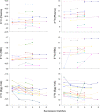Isotope analysis reveals foraging area dichotomy for atlantic leatherback turtles
- PMID: 18365003
- PMCID: PMC2267998
- DOI: 10.1371/journal.pone.0001845
Isotope analysis reveals foraging area dichotomy for atlantic leatherback turtles
Erratum in
- PLoS One. 2009;4(7). doi: 10.1371/annotation/17755b0c-3597-4da2-be87-08a14caba677
- PLoS One. 2009;4(7). doi: 10.1371/annotation/72a9b040-40d8-495a-a4aa-a7ea8fd00de8
- PLoS One. 2009;4(7). doi: 10.1371/annotation/de853c89-d3eb-441f-8d87-0366bb1533b5. Fossette, Sabrina [added]; Georges, Jean-Yves [added]
- PLoS One. 2009;4(8). doi: http://www.pubmedcentral.nih.gov/articlerender.fcgi?artid=2727527
Abstract
Background: The leatherback turtle (Dermochelys coriacea) has undergone a dramatic decline over the last 25 years, and this is believed to be primarily the result of mortality associated with fisheries bycatch followed by egg and nesting female harvest. Atlantic leatherback turtles undertake long migrations across ocean basins from subtropical and tropical nesting beaches to productive frontal areas. Migration between two nesting seasons can last 2 or 3 years, a time period termed the remigration interval (RI). Recent satellite transmitter data revealed that Atlantic leatherbacks follow two major dispersion patterns after nesting season, through the North Gulf Stream area or more eastward across the North Equatorial Current. However, information on the whole RI is lacking, precluding the accurate identification of feeding areas where conservation measures may need to be applied.
Methodology/principal findings: Using stable isotopes as dietary tracers we determined the characteristics of feeding grounds of leatherback females nesting in French Guiana. During migration, 3-year RI females differed from 2-year RI females in their isotope values, implying differences in their choice of feeding habitats (offshore vs. more coastal) and foraging latitude (North Atlantic vs. West African coasts, respectively). Egg-yolk and blood isotope values are correlated in nesting females, indicating that egg analysis is a useful tool for assessing isotope values in these turtles, including adults when not available.
Conclusions/significance: Our results complement previous data on turtle movements during the first year following the nesting season, integrating the diet consumed during the year before nesting. We suggest that the French Guiana leatherback population segregates into two distinct isotopic groupings, and highlight the urgent need to determine the feeding habitats of the turtle in the Atlantic in order to protect this species from incidental take by commercial fisheries. Our results also emphasize the use of eggs, a less-invasive sampling material than blood, to assess isotopic data and feeding habits for adult female leatherbacks.
Conflict of interest statement
Figures



Similar articles
-
Persistent leatherback turtle migrations present opportunities for conservation.PLoS Biol. 2008 Jul 15;6(7):e171. doi: 10.1371/journal.pbio.0060171. PLoS Biol. 2008. PMID: 18630987 Free PMC article.
-
Identification of distinct movement patterns in Pacific leatherback turtle populations influenced by ocean conditions.Ecol Appl. 2012 Apr;22(3):735-47. doi: 10.1890/11-0633. Ecol Appl. 2012. PMID: 22645807
-
Assignment tests, telemetry and tag-recapture data converge to identify natal origins of leatherback turtles foraging in Atlantic Canadian waters.J Anim Ecol. 2013 Jul;82(4):791-803. doi: 10.1111/1365-2656.12056. Epub 2013 Mar 6. J Anim Ecol. 2013. PMID: 23464527
-
Biology, Nesting Behavior, Genetic Diversity, and Conservation of Leatherback Sea Turtles: Insights From Thailand and Global Perspectives.Ecol Evol. 2025 Feb 20;15(2):e71014. doi: 10.1002/ece3.71014. eCollection 2025 Feb. Ecol Evol. 2025. PMID: 39991445 Free PMC article. Review.
-
A systematic review protocol for quantifying bycatch of critically endangered leatherback sea turtles within the Pacific Ocean basin.Environ Evid. 2024 Nov 29;13(1):27. doi: 10.1186/s13750-024-00352-3. Environ Evid. 2024. PMID: 39614399 Free PMC article. Review.
Cited by
-
The evolution of intermittent breeding.J Math Biol. 2013 Mar;66(4-5):685-703. doi: 10.1007/s00285-012-0603-0. Epub 2012 Oct 18. J Math Biol. 2013. PMID: 23076830
-
Movement patterns for a critically endangered species, the leatherback turtle (Dermochelys coriacea), linked to foraging success and population status.PLoS One. 2012;7(5):e36401. doi: 10.1371/journal.pone.0036401. Epub 2012 May 16. PLoS One. 2012. PMID: 22615767 Free PMC article.
-
Identifying patterns in foraging-area origins in breeding aggregations of migratory species: Loggerhead turtles in the Northwest Atlantic.PLoS One. 2020 Apr 13;15(4):e0231325. doi: 10.1371/journal.pone.0231325. eCollection 2020. PLoS One. 2020. PMID: 32282844 Free PMC article.
-
Historical versus contemporary climate forcing on the annual nesting variability of loggerhead sea turtles in the Northwest Atlantic Ocean.PLoS One. 2013 Dec 5;8(12):e81097. doi: 10.1371/journal.pone.0081097. eCollection 2013. PLoS One. 2013. PMID: 24339901 Free PMC article.
-
Telomeres, age and reproduction in a long-lived reptile.PLoS One. 2012;7(7):e40855. doi: 10.1371/journal.pone.0040855. Epub 2012 Jul 13. PLoS One. 2012. PMID: 22808278 Free PMC article.
References
-
- Girondot M, Fretey J. Leatherback turtles, Dermochelys coriacea, nesting in French Guiana, 1978–1995. Chelonian Conservation and Biology. 1996;2:204–208.
-
- Girondot M, Tucker AD, Rivalan P, Godfrey M, Chevalier J. Density-dependant nest destruction and population fluctuations of Guianan leatherback turtles. Animal Conservation. 2002;5:75–84.
-
- Ferraroli S, Georges JY, Gaspar P, Le Maho Y. Endangered species-Where leatherback turtles meet fisheries. Nature. 2004;429:521–522. - PubMed
-
- Eckert SA. High-use oceanic areas for Atlantic leatherback sea turtles (Dermochelys coriacea) as identified using satellite telemetered location and dive information. Marine Biology. 2006;149:1257–1267.
-
- Davenport J. Sustaining endothermy on a diet of cold jelly: energetics of the leatherback turtle Dermochelys coriacea. British Herpetological Society Bulletin. 1998;62:4–8.

